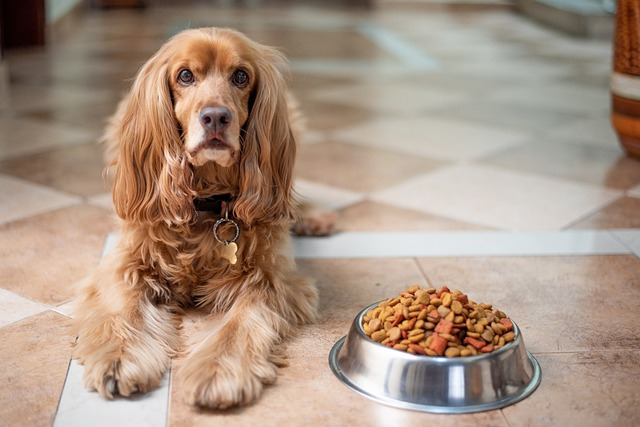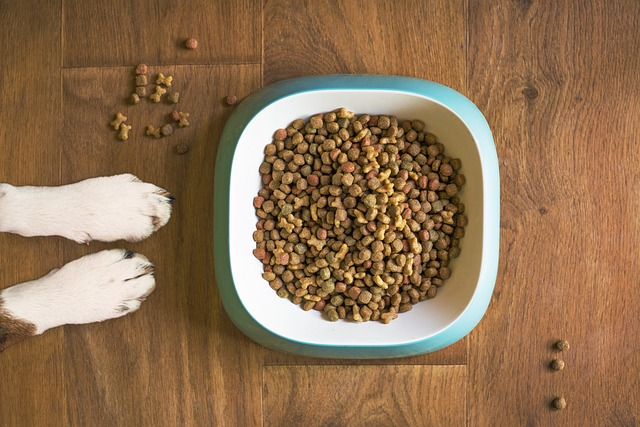What is the Best Dog Food for Weight Loss: Slimming Secrets

Have you ever looked at your furry friend and wondered how you could help them lead a healthier, more vibrant life?
The secret might just lie in their food bowl.
As a devoted dog parent, you understand that weight management is more than just a number on a scale; it’s about enhancing your dog’s overall well-being and longevity.
In this article, we’re diving into the world of dog food specifically formulated for weight loss.
We’ll explore how the right diet can not only trim down your pup’s waistline but also boost their energy and vitality.
Whether you’re dealing with a stubbornly plump pooch or just aiming for optimal health, this guide is your roadmap to making informed, loving choices for your canine companion.
Key Takeaways
- Different dog breeds have unique nutritional requirements for weight loss. It’s essential to choose dog food based on breed size, activity level, and specific health conditions.
- Understanding dog food labels and pet food regulations is key. Look for high-quality protein sources, moderate healthy fats, and fiber content, and avoid artificial additives.
- Effective weight management in dogs involves more than just diet. It includes a combination of regular exercise, portion control, and monitoring progress through weigh-ins and body condition scoring. Consultation with a veterinarian is crucial for personalized advice and adjustments.
Importance of Proper Dog Food for Weight Loss

Choosing the right dog food, particularly dry dog food and wet dog food, is crucial for managing a dog’s weight, especially for overweight dogs. A diet designed for weight management can help your dog lose weight effectively.
Pet foods formulated for adult dogs should focus on weight control, with options like low-fat dog food and grain-free dog food being particularly beneficial.
Here’s a breakdown of why and how the right dog food matters:
- According to PetMD, the right dog food helps in managing calorie intake and portion sizes, which is vital for weight loss. Veterinarians often calculate the calories a dog needs, targeting a maximum goal of losing 2% of the initial body weight per week. This helps in reducing excess weight efficiently without compromising on nutritional needs.
- A diet specifically designed for weight loss is key. It should be balanced and consider the dog’s unique dietary requirements. This approach not only aids in weight management but also maintains the dog’s health.
- High-quality dog foods for weight loss typically have lower calorie content but are high in fiber and essential nutrients. This combination is effective in supporting weight management. It contributes to weight reduction while keeping the dog full and satisfied, which helps prevent overeating.
- It’s important that a weight loss diet for dogs focuses not just on losing fat, but also on maintaining muscle mass. This is crucial for the dog’s overall health and mobility.
- Depending on various factors, a minimum desired rate of weight loss can be around 0.5% of the initial body weight per week. This rate is important to ensure safe and healthy weight loss.
Key Ingredients in Dog Food for Effective Weight Loss

When selecting weight loss food, it’s vital to focus on ingredients that help dogs lose weight. That not only helps in shedding extra pounds but also ensures your dog is receiving the necessary nutrition. Here’s a list of top ingredients to look for:
- Lean Proteins: Incorporate high-quality proteins such as chicken meal, turkey, or fish. These lean proteins are crucial for building and maintaining muscle mass in your dog, which is essential during weight loss. They provide the necessary nutrients without adding extra fat and they should be a staple in your dog’s diet.
- Fiber: Look for ingredients high in fiber like brown rice, sweet potatoes, or even pumpkin. Fiber is important for digestion and plays a key role in helping your dog feel full and satisfied. This can prevent overeating and assist in better weight management.
- Healthy Fats: Healthy fats are vital, despite the goal being weight loss. Choose dog foods containing moderate levels of beneficial fats, such as those found in salmon oil or flaxseed. These fats are important for maintaining a healthy coat and skin, and they provide essential fatty acids that are crucial for overall health.
- Complex Carbohydrates: Opt for dog foods that include complex carbohydrates like oatmeal or barley. These carbs offer sustainable energy and help in regulating blood sugar levels, which is important for maintaining a healthy weight.
- Avoid Fillers: It’s important to steer clear of dog foods that contain fillers like corn, wheat, or soy. These fillers offer little nutritional value and can contribute to unwanted weight gain in dogs.
By ensuring these key ingredients are present in your dog’s diet, you’re not just aiding in weight loss but also contributing significantly to their overall health and well-being.
Ingredients to Avoid in Weight Loss Dog Food
When focusing on weight loss for your dog, understanding what not to include in their diet is as important as knowing what to include. Certain ingredients can hinder your dog’s weight loss progress and negatively impact their health. Here’s a list of ingredients to avoid:
- Corn, Wheat, and Soy: These are commonly used as fillers in dog food. They offer minimal nutritional value and can lead to weight gain, allergies, and digestive issues in dogs.
- Artificial Additives and Preservatives: These can be harmful to your dog’s health and add no nutritional value to their diet. It’s best to avoid these to ensure your dog’s food is as natural and beneficial as possible.
- High Carbohydrate Content: Foods with excessive carbohydrates can contribute to weight gain and impede weight loss efforts. It’s important to look for foods with lower carbohydrate levels.
- Sugar and Sweeteners: These add unnecessary calories to your dog’s diet and can negatively affect their weight loss. Avoid dog foods with added sugars or sweeteners.
- Unhealthy Fats: Avoid dog foods that contain high levels of unhealthy fats, such as excessive animal fats or vegetable oils, as these can contribute to obesity.
Types of Dog Food Suitable for Weight Loss
According to VCA Hospitals, various types of dog food are formulated to help shed a few pounds, and each offers unique benefits. Grain-free diets and wet food formulas are also available for dogs with specific dietary needs. Here’s a comparison of different types:
- Royal Canin Calorie Control
- Type: High-Protein
- Key Benefits: This formula supports muscle mass and increases satiety, helping dogs feel full, which is beneficial in managing their weight.
- Hill’s Science Diet Light
- Type: Low-Calorie
- Key Benefits: Specifically designed for weight management, this dog food offers fewer calories per serving, making it easier to control calorie intake.
- Merrick Grain-Free Diets
- Type: Grain-Free Diets
- Key Benefits: Ideal for dogs with grain sensitivities, this option focuses on high-quality protein sources to support a healthy diet without the inclusion of grains.
- Purina Proplan OM Overweight Management
- Type: Weight Management Dog Foods
- Key Benefits: Tailored for weight loss, it includes L-carnitine which aids in metabolism support, helping in the effective management of the dog’s weight.
Consulting Your Veterinarian: A Key Step
Always consult a board-certified veterinary nutritionist or your vet before changing your pet’s weight management plan. They can guide you on dry foods versus wet food, and advise on prescription food options. Here are some questions to ask your vet:
- What type of weight loss dog food is best for my dog’s breed and age?
- Are there any health conditions I should consider when choosing a diet?
- How much food should I feed my dog daily for effective weight loss?
- Can you recommend specific brands or formulas that would be suitable?
- How often should I monitor my dog’s weight and overall health during their diet?
Remember, your vet’s guidance is invaluable in ensuring a safe and effective weight loss journey for your dog.
Breed-Specific Considerations for Weight Loss Dog Food

Different breeds may need different weight loss foods depending on their dog’s life stage and risk of serious health problems like heart disease. It’s important to choose a dog food that caters to your dog’s breed size, activity level, and specific health conditions.
Here’s a guide to help you understand breed-specific dietary needs:
- Small Breeds (e.g., Chihuahua, Pomeranian): Require high-protein, nutrient-dense food due to their fast metabolism.
- Medium Breeds (e.g., Beagle, Cocker Spaniel): Benefit from balanced diets with controlled calorie intake.
- Large Breeds (e.g., Labrador, German Shepherd): Need diets that support joint health and have moderate calorie content to prevent obesity.
- Active Breeds (e.g., Border Collie, Australian Shepherd): Require high-energy food with higher protein and fat content.
- Senior Dogs: Often need lower-calorie diets with high fiber to maintain weight and support digestive health.
Reading Labels and Understanding Pet Food Regulations
Understanding dog food labels and regulations is crucial for choosing the right food for your dog’s weight loss. Here are key elements to look for:
- Guaranteed Analysis: This section on the label provides crucial information about the nutrient content, such as protein, fat, fiber, and moisture levels. It helps you assess the nutritional value of the dog food.
- Ingredient List: Ingredients are listed in order of weight. High-quality protein sources like chicken, turkey, or fish should ideally be listed first, indicating their abundance. This aligns with your previous emphasis on protein content.
- Feeding Guidelines: These are essential to understand the recommended serving sizes and how often to feed your dog, aiding in managing portion sizes and overall calorie intake.
- Healthy Fats: Look for moderate levels of healthy fats, including omega-3 fatty acids, as they are important for overall health, aligning with your previous point about fat percentage.
- Fiber Sources: Fiber is crucial for digestion and satiety. Good sources include ingredients like sweet potatoes and brown rice, which you’ve already highlighted.
- Calorie Content: Understanding calorie content is key for weight management, especially for weight loss diets.
- Pet Food Regulations Knowledge: Familiarize yourself with pet food regulations, such as those set by the Association of American Feed Control Officials (AAFCO). This knowledge ensures you choose a product that meets safety and nutritional standards.
Implementing a Holistic Approach to Weight Loss in Dogs
To effectively manage your dog’s weight loss, it’s essential to combine diet, regular exercise, and portion control. Here are some lifestyle changes to support your dog’s journey:
- Regular Exercise: Engage your dog in daily physical activities like walks and playtime. However, consult your veterinarian about your dog’s unique capabilities and needs before starting a new exercise routine. It’s crucial to tailor the exercise to your dog’s health and fitness level.
- Portion Control and Feeding Routine: Measure out the exact amount of food as directed by your veterinarian. Instead of one or two large meals, feed your dog several smaller meals throughout the day. This approach helps keep your dog satiated and prevents overeating.
- Healthy Diet: Choose a balanced diet formulated for weight loss. Your vet can adjust your dog’s diet and exercise routine, ideally aiming for a 1-2% body weight loss per week. Be aware that dogs often lose weight in a stair-step fashion, with periods of rapid loss followed by periods of slower loss.
- Routine Check-ups: Regular veterinarian visits are crucial to monitor health and adjust diet and exercise as needed. Major alterations in diet plans are generally not done unless weight has not changed in two consecutive examinations.
- Limit Treats: Limit treats and stick to vet-approved, low-calorie options like carrot slices, green beans, small amounts of cooked lean meat, packaged low-calorie treats, and broccoli. According to the American Kennel Club (AKC), treats should still only comprise less than 10% of your dog’s total caloric intake even after reaching the target weight.
Monitoring Progress: Weight and Body Condition After Achieving Ideal Weight
Monitoring your dog’s weight and body condition is essential, not just during the weight loss process but also after reaching the target weight. Here’s a guide to help you keep track:
- Regular Weigh-Ins: Continue to weigh your dog regularly, even after they have reached their target weight. This helps in ensuring that the ideal weight is maintained over time.
- Monthly Weight Monitoring: Once the target weight is achieved, it’s important to monitor your dog’s weight on a monthly basis. This regular check helps in quickly identifying any weight gain or loss, allowing for timely adjustments to their diet or exercise routine.
- Body Condition Scoring: Keep using a body condition score chart to assess your dog’s fat and muscle levels. This is a useful tool to ensure your dog remains at a healthy weight.
- Visual Assessment: Continue with visual assessments. Look for a visible waist and palpable ribs without excess fat, which are indicators of a healthy weight.
- Vet Visits: Regular veterinary check-ups are still crucial. They ensure that your dog maintains their ideal weight and overall health.
By following these steps, you can effectively monitor and maintain your dog’s weight, ensuring they stay healthy and happy long after the diet plan is completed. Remember, consistent monitoring and adjustments are key to successful weight management.
Conclusion
In conclusion, managing your dog’s weight is a multifaceted endeavor that extends beyond just choosing the weight management dog food. It’s about understanding the unique needs of your dog’s breed, carefully reading and interpreting food labels, and embracing a holistic approach that combines proper nutrition with regular exercise and vigilant monitoring.
Remember, each dog is unique, and what works for one may not work for another. Regular consultations with your veterinarian are essential to tailor a weight loss plan that is both effective and safe for your beloved pet.
By being a responsible and informed pet owner, you can help your dog achieve a healthier weight, leading to a happier, more active, and fulfilling life.
